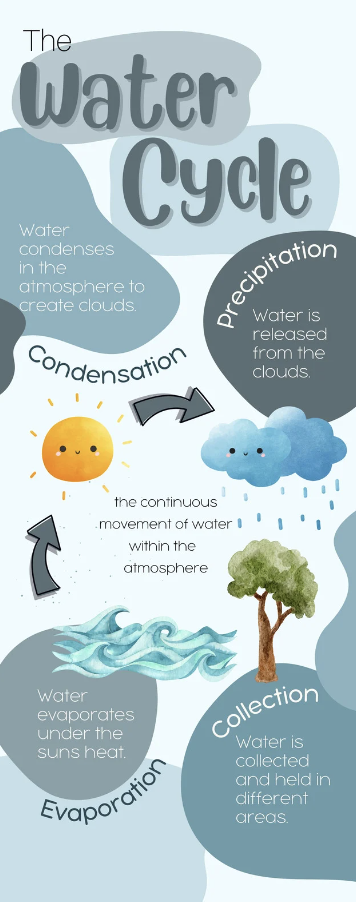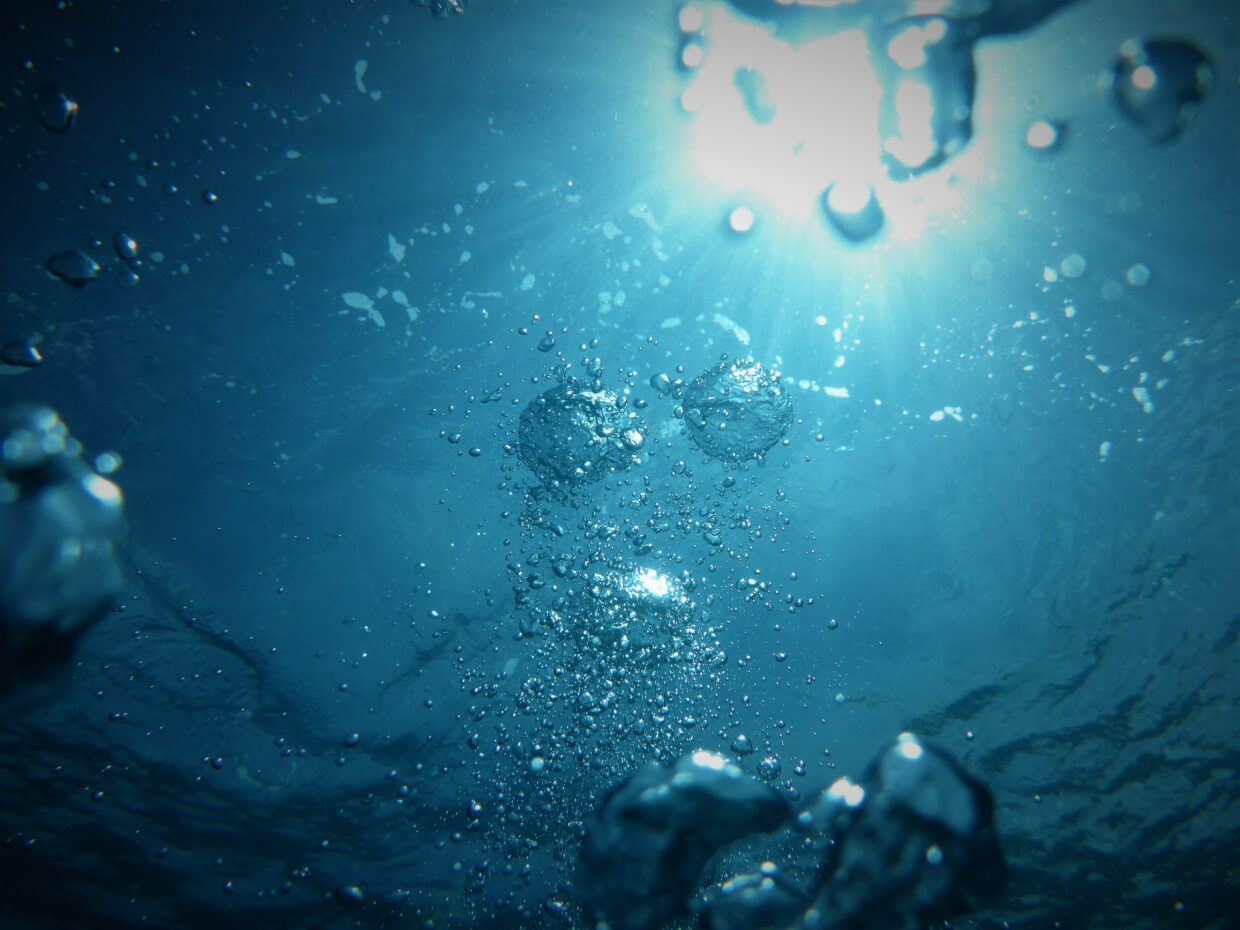In this module, I had the opportunity to explore learning design and active learning principles. I was able to create activities using H5P for my lesson plan, including the drag and drop label activity and multiple choice/true or false questionnaire. As well as learn the different sections that go into creating a lesson plan and how each section plays a significant role in both passive and active learning. In the end, I reflected on my experience using HP5 and how these principles are integrated into my learning.
Lesson Plan: Understanding the Water Cycle
Overview:
In this lesson, students will explore how the water cycle works and why it is important to the planet. The water cycle is essential to learning because water plays a significant role in everyday living and is a necessity for living. It is the reason that water is able to support all life forms on Earth, including plants, animals and humans. It not only sustains living organisms but also non-living components on Earth, such as soil and the atmosphere. Without the water cycle, the planet would run out of clean water and everything would be negatively affected. As individuals, we can contribute positively to the water cycle by participating in activities that promote the environment and by having a clear understanding of the interconnected pathways involved in the water cycle.
Lesson Objectives:
By the end of this lesson, learners will be able to:
- Understand the importance of water in our daily lives.
- Describe the cycle and the phases.
- Identify the different states of water within the water cycle phases.
- Understand how they can play a key role in positively impacting the water cycle.
Read/Watch:
- The Water. Looking after our Planet | Educational Video for Kids – (4 minutes) – An educational video for kids on why water plays an important role in our planet.
- The Water Cycle | The Dr.Binocs Show | Learn Videos For Kids – (3 minutes) – The phases of the water cycle.
- The Water Cycle – How rain is formed – Lesson for Kids – (2 minutes) – A video explaining how rain is formed with the water cycle phases.
- The Water Cycle Phases – (2-3 minute read) – The article explains each phase in depth and the different states of water involved in the water cycle.
- Let’s Talk About Water – (2-minute read) – The article explains why water is essential to Earth and what humans can do to support the water cycle.
Content:
To prepare learners to understand the water cycle and its importance, infographics will be shown in the lesson for those who are visual learners. Greenwood (n.d) mentions that learning is promoted when the instruction demonstrates what is to be learned. A visual diagram with boxes unlabeled and ready to fill in with each phase will be shown to demonstrate the phases of the water cycle. These additional demonstrations will prepare learners to label the phases in the application section.


Application:
Learners will apply what they have learned from the lesson by practicing their understanding of the water cycle using the HP5 activities below:
Learners will also apply their knowledge by sharing to the class their thoughts/ideas and by capturing a photo to demonstrate their critical thinking/knowledge about the water cycle.
- Discussion Forum: Students will go outside and capture 3 photos of something/someone that relies on water. Then write a 1 paragraph for each photo about how it connects to the water cycle phases and the importance of what was captured in daily life. What would happen if there was no water? How will this affect what you captured?
- Reply to Peers: Reply to 1 peer’s discussion posts. Answer the following questions: What was something new that you learned? How has your peer’s post helped your understanding of the water cycle?
Reflection
After completing the lesson, learners will participate in a group discussion forum to reflect on their experiences and learning in this lesson. Learners can choose 2 questions from the list below:
- What are two ways you will apply the water cycle in your daily life?
- Can you describe how the water cycle plays a significant role in the environment? Make sure to use the four phases of the water cycle to support your reasoning.
- From what you learned in this lesson, what was the most interesting to you? What was the most challenging part of your learning in this lesson?
- Has your perspective about water and the environment changed after this lesson? If so, explain what you will do now that you have a better understanding. If not, explain what you are already doing to support the environment?
To Do This Week:
- Watch the video on The Water. Looking after our Planet | Educational Video for Kids – (4 minutes)
- Watch the video on The Water Cycle | The Dr.Binocs Show | Learn Videos For Kids – (3 minutes) – The phases of the water cycle.
- Watch the video on The Water Cycle – How rain is formed – Lesson for Kids – (2 minutes) – A video explaining how rain is formed with the water cycle phases.
- Read the article The Water Cycle Phases – (2-3 minute read) – The article explains each phase in depth and the different states of water involved in the water cycle.
- Read the article Let’s Talk About Water – (2-minute read) – The article explains why water is essential to Earth and what humans can do to support the water cycle.
- Complete H5P Activity: Drag and Drop The Water Cycle Phases.
- Complete H5P Activity: Multiple Choice/True or False Questionnaire.
- Post to the Discussion Forum: Capture 3 photos and explain how they connect to the water cycle phases. What would happen if there was no water? How will this affect what you captured?
- Reply to your peers’ discussion posts, make sure you reply to 1 classmate.
- Use the reflection questions and discuss with 3-4 peers.
Reflection Questions on Module 4:
What was your experience of trying out H5P? Which of the activities do you think you would make the most use of in your teaching context and what would you use them to do? Which ones do you think require the most resources to create?
I found my experience with trying out H5P a bit challenging at first. My first attempt with it was creating a drag-and-drop labelling diagram and I was struggling. I then decided to watch the HP5 tutorial on how to add draggable boxes/labels, however, I found the instructions did not go over creating the boxes and connecting them to the correct label. I then tried looking for a YouTube tutorial and finally came across a video that helped me successfully create the activity. I found creating the multiple choice/true or false questionnaire much easier to create. I believe the drag-and-drop activity would make the most use of my teaching context, especially if the lesson is for elementary-level learners. I believe it is an excellent way to assess students learning and also for learners to be engaged and have fun with learning since it is interactive. I believe the course presentation and interactive video would require the most resources to create because of my experience creating the video presentation for Assignment #2. I found it overall time-consuming as I had to prepare a script, record videos, and edit. Similarly, the creation of these resources would also be time-consuming but also require the teacher to connect ideas from the lesson to the presentation/interactive video. As well as record themselves presenting and also have the interactive aspect in mind while creating it.
How have you found the balance of passive and active learning in this course for your learning? How does it compare to your experience in other courses?
Overall, I find that the course has a great balance between passive and active learning. Each module starts with passive learning by reading articles and watching videos. Then explaining the concepts and theories in great depth that is later used for the active learning portion (reflection questions/activities) at the end of the module. I find that this teaching structure of starting with passive learning and then transforming to active learning helps me grasp the knowledge more effectively. With other courses, such as my Psychology courses, I find that we stay in passive learning for a long time mainly lectures/readings. After a while, I am assigned assignments or tested on exams. I find a course that integrates passive and active learning close in time, such as a module or discussion forum right after readings is the most helpful in my learning.
References
Happy Learning English. (2017, June 6) The Water, Looking after our Planet | Educational Video for Kids [Video]. YouTube. https://www.youtube.com/watch?v=bGWr5jXJfbs
PeekaBoo Kidz. (2015, March 11). The Water Cycle | The Dr. Binocs Show | Learn Videos For Kids [Video]. YouTube. https://www.youtube.com/watch?v=ncORPosDrjI
Learning Junction. (2014, July 18). The Water Cycle – How rain is formed – Lesson for Kids [Video]. YouTube. https://www.youtube.com/watch?v=s0bS-SBAgJI
National Geographic Kids. (n.d.). The Water Cycle Phases. National Geographic Kids. natgeokids.com/uk/discover/science/nature/water-cycle/
National Institute of Environmental Health Sciences. (n.d.). Kids Environment Kids Health. https://kids.niehs.nih.gov/topics/pollution/water/talk-about-water
Greenwood, J. (n.d.). Merrill’s first principles of instruction. James Greenwood. https://james-greenwood.com/instructional-design/toolkit/merrill/

jaswant 2023-11-12
Hello Nataly,
Once again an amazing blog post. I thoroughly enjoyed reading your post. water is very important for all living being and thus water cycle is also important. I want to ask you how the idea of creating lesson on water cycle came in your mind?
There are few mistakes in the blog:
1. There is a typo in first paragraph, it should be H5P not HP5.
2. Missing a diagram for this question “what phase is #4 in the diagram?”.
3. The last reference is too big which is messing with beauty/looks/background of this post.
Overall, your lesson provides precise information about the water cycle. Thank you for sharing such amazing post . Excited to see more posts from you.
mellakany 2023-11-24
Hello Nat, I really liked reading your lesson plan. I remember learning about the water cycle in elementary school. The teacher had us create little bracelets with beads to represent each step of the cycle. In your read/watch section, I really liked how you specified each video and reading time. This makes it easy to plan the lesson ahead of time. Your infographic is so cute too! I used the H5P applications and found them very useful, even as a university student. It allowed me to review my knowledge. I also had a few difficulties creating the H5P activities. It was a good idea to look for videos online.
Thanks,
Maya El-Lakany
zhongbaoji 2023-11-25
Hello Nataly,
My name is Zhongbao Ji, I really appreciate your detailed explanation of how the water cycle works and why it is so important to the earth. At the same time, I really like the video you shared which is An educational video for kids on why water plays an important role in our planet. I think maintaining water circulation is also a very important thing for Canada’s public sector. If you can share some information about the Canadian government It would be nice to have some contributions from Canadians in this regard, because I know that Canada is an environmentally friendly country, and Canadians are also very concerned about environmental safety and water resources.
lizcheng 2023-11-26
Hi! I believe you’ve pretty much used the scaffolding strategies in your lesson by (1) providing important vocabulary through the use of an infographic (2) Talking about it by providing guiding questions that will allow students to reflect on what they have learned (3) You also listed relevant videos (show what you mean) and used 2 H5P (use of technology). The instructions in the to-do list are also very detailed and clear. Awesome blogpost! =)